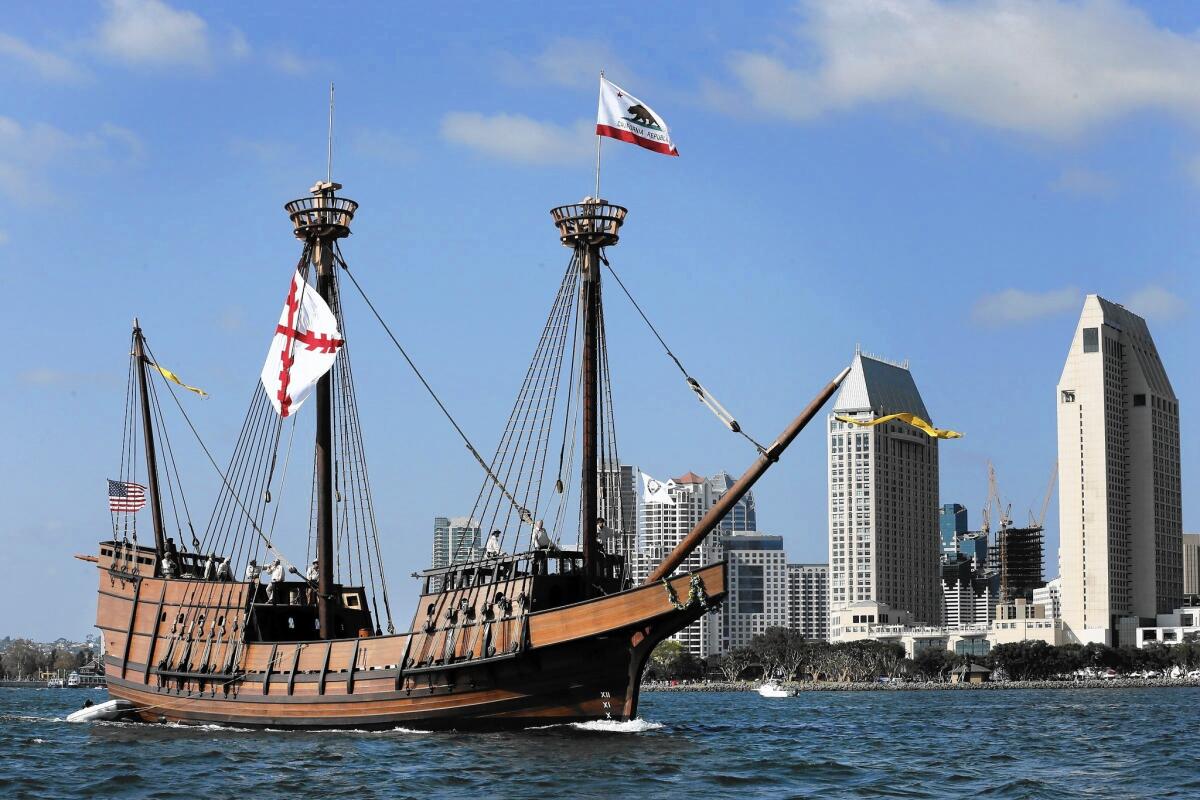Mystery of Cabrillo’s birthplace may have been solved by historian

For centuries, Portugal and Spain have vied for the honor of claiming explorer Juan Rodriguez Cabrillo as their own. The conquistador has been a shadowy figure and historians have hunted in vain for documentation of his birthplace.
Now a Canadian researcher may have solved the mystery.
Ancient documents unearthed by Wendy Kramer indicate that Cabrillo — whose 1542 landing in San Diego was Europe’s first foray into California — was Spanish.
“This,” Cabrillo National Monument historian Robert Munson said, “could be the smoking gun.”
Last month, Kramer logged into the online General Archive of the Indies. Examining digitized documents from a 1532 lawsuit involving the theft of New World gold from a Spanish vessel, Kramer was stunned by the testimony of one witness.
He was identified as Juan Rodriguez Cabrillo, natural de (native of) Palma de Micergilio.
A town in the province of Cordoba, Spain.
“Look who was on the boat!” Kramer remembers exclaiming.
Her find, Munson said, is a major historical breakthrough.
“Right now, all the circumstantial evidence points in the right direction,” he said.
Yet Idalmiro Manuel da Rosa — president of San Diego’s Cabrillo Festival, an annual event that celebrates the navigator as well as the local Portuguese American community — finds the news disturbing.
“I’ve requested that the documents be sent to us so we can turn them over to the Portuguese government,” da Rosa said. “We definitely want to get to the bottom of this.”
Kramer’s research is rooted in the Archives of the Indies, a storehouse of records from Spain’s colonial era. Other historians now are scanning the 483-year-old documents — and finding them persuasive.
Munson, for example, noted that Cabrillo testified to his Spanish roots while under a sacred oath.
“These people lived in an era when invoking the name of God is putting your immortal soul in danger,” he said. “There would be no reason for Cabrillo to perjure himself on this.”
::
Kramer, 59, admits that her specialty — colonial Guatemalan history — is not the sexiest topic.
“Most of my friends’ eyes glaze over,” she said.
Yet she’s been entranced by the topic since the 1970s when, as a college student, she traveled to Central America and became swept up in the tales of 16th century Spanish adventurers creating a new society there.
Still fascinated by the first generation of conquistadors in Guatemala decades later, she set out to write brief biographies of each, working alphabetically.
Last month, arriving at the letter C, she was investigating Gabriel de Cabrera.
The archives’ online index led Kramer to three cases involving the lawyer, who had been transporting two chests of gold to Spain — taxes owed to the crown, as well as private individuals’ funds. He and this treasure boarded a ship in San Juan de Ulúa — present-day Veracruz — and sailed for Cadiz by way of Cuba.
When the vessel landed in Havana, Cabrera’s journey was interrupted.
“Some of the gold that he was taking to the crown was stolen while he was on the boat,” Kramer said. “These guys get hauled off to jail and authorities start putting together this big case.”
The trial dragged on through hearings in Havana, Tenerife, Cadiz and Seville. Among the witnesses testifying were passengers from the voyage — including Juan Rodriguez Cabrillo, born in Palma de Micergilio.
But were that man and the famed explorer one and the same?
In separate documents, Juan Rodriguez de Palma is linked to personal details — conquering the Aztecs with Hernan Cortés and marrying a Spanish woman — that conform with what historians already know about the explorer. Moreover, his presence in Spain in 1532 is well documented.
“It is pretty clear,” said Harry Kelsey, a Huntington Library research scholar and biographer of Cabrillo, “that the man who made this statement is the same Juan Rodriguez Cabrillo.”
::
Cabrillo made landfall on what is now Point Loma on Sept. 28, 1542. He was 43 or 44 — his exact birth date in 1499 is unknown — and had little more than three months to live.
After a brief stay in San Diego Bay, his expedition sailed north and charted the California coast beyond San Francisco. Sailing south, his flotilla stopped in the Channel Islands, where Cabrillo suffered a broken bone. He died weeks later.
At the national monument marking the explorer’s arrival in what now is California, there is a statue of him perched high above the Pacific. It was commissioned by Portugal in 1939.
“The Portuguese government has proof that he was Portuguese,” Da Rosa said. “And in Portugal, there is a town, Cabril, and it is assumed he was born near there.”
Still, historians have been unable to reach a consensus on Cabrillo’s birthplace.
Kramer said her discovery of Cabrillo’s 1532 testimony was a fluke: “It was buried in a document that had nothing to do with him,” the researcher said. Yet the find has added credibility because it is in the 16th century equivalent of a court reporter’s official transcript.
Kramer has found three documents with Cabrillo’s testimony; in two, he identified himself as a native of Palma de Micergilio. In the third case, he called himself Juan Rodriguez de Palma.
“You Cabrillo-in-Spain deniers will say it’s not the same guy,” Kramer said. “But this is him.”
[email protected]
Peter Rowe writes for the San Diego Union-Tribune.
ALSO:
L.A. archbishop reaches out to Catholic students in digital age
Tsunami surge could help experts predict future ocean events
State panel outlaws ‘dark money’ in California political campaigns
More to Read
Sign up for Essential California
The most important California stories and recommendations in your inbox every morning.
You may occasionally receive promotional content from the Los Angeles Times.









